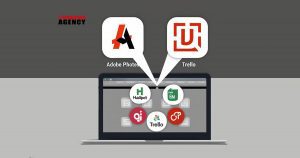Launching a new app in today’s crowded marketplace takes careful planning and execution. With over 5 million apps across the major app stores, standing out from the crowd is a monumental challenge. However, with the right launch strategy, your app can gain the visibility it needs to succeed. Today, we will guide you on ”how to launch an app” and prepare it for a soft landing.
In this comprehensive guide, we’ll walk through the key steps involved in launching an app – from initial research all the way to post-launch monitoring and updates. Whether you’re developing your first app or are a seasoned pro, this guide will provide actionable tips and tools to help your app launch go as smoothly as possible.
How to Launch an Application: Research & Planning
Laying the proper groundwork through research and planning is what sets successful app launches apart. Don’t rush into development without taking the time to understand your market, competitors, and target users.
Conduct Thorough Market Research on Competitors
Before even thinking about features or technical requirements, take time to immerse yourself in your target app category. Download and use the most popular apps in the space. Analyze both direct and indirect competitors, even if they are vastly different from your initial idea.
Look beyond the product features to how these apps market themselves, acquire users, communicate value propositions, and retain users. Read through all their app store listings closely, especially user reviews. This competitive analysis will help you identify gaps or unmet user needs, enabling you to focus your own app on them. It also ensures you don’t repeat the obvious mistakes of others.
Furthermore, conducting competitor research will reveal valuable insights into your rivals’ existing market share, pricing strategies, identified market gaps, and the strengths and weaknesses inherent in their products.
Define Your Target Audience with Detailed User Personas
With market research complete, synthesize your findings to define one or more detailed target user personas. Outline demographic information like age, location, gender, income level, education, interests, and occupation. Also include contextual details on their pain points, frustrations, motivations, and goals.
Aligning with a target user will enable you to hone your app’s features, messaging, visual style, and marketing channels to resonate with that demographic specifically. Avoid the temptation to create something too broad in an attempt to reach everyone. A niche focus wins out every time.
Set Goals and Key Performance Indicators to Define Success
Have clearly defined objectives and quantifiable metrics for what success looks like. Setting goals and KPIs early will shape priorities in development, marketing, and every other initiative pre and post-launch.
Consider benchmarks like number of downloads, daily/monthly active users, retention rate after one month or one year, average session time, revenue, star ratings, and app store ranking. Derive realistic targets based on research of similar apps in your category. Defining tangible success metrics also helps secure funding.
Determine Pricing Models and Monetization Strategy
Decide early on whether your app will be free, freemium, paid, or subscription-based. Each model has tradeoffs to consider. Free apps rely solely on in-app ads, requiring massive user volume. Freemium limits advanced features for unpaid users. Paid apps are harder to gain users but earn revenue upfront. Subscriptions allow recurring revenue but may turn some users away.
Factor in your audience, value proposition, and direct versus indirect competitors when selecting pricing. For paid apps, use data to pick an optimal price point. Free trials or introductory discounts can help overcome objections during launch. You can always adjust your pricing later based on user data.
Design Visuals and Branding for Marketing
While the final look and feel will still evolve, early conceptual visuals are crucial for conveying your app even before it’s built. Mockup screenshots of your app flows and interface. Develop a style guide covering color schemes, fonts, and interface elements.
This branding will help marketing assets like your landing page, explainer video, and app store screenshots maintain a cohesive visual language. It sets user expectations and forms first impressions.
Claim Your Domain and Launch a Landing Page
Secure the domain name for your app or brand as soon as possible even if you’re far from launch. Use it to create a simple one-page landing page announcing your upcoming app and its value proposition.
Include a signup form to build an email list of potential early adopters. Landing pages establish a web presence and give interested users a destination to learn more details.
 How to Launch an Application: Before the Launch
How to Launch an Application: Before the Launch
With your app researched and planned out, it’s time to start building genuine excitement and buzz leading up to launch day. Focus on organically engaging with potential users instead of traditional advertising and direct sales pitches.
Establish Social Media Accounts to Interact with Followers
Leverage platforms like Twitter, Facebook, LinkedIn, and maybe TikTok to interact with interested users. Share industry news, behind-the-scenes peeks, and valuable content related to your app niche. Respond to comments and questions to foster a community.
Avoid overt self-promotion early on. Social media will help drive followers to your landing page and spread the word to relevant audiences. Remember, social presence builds trust and credibility.
Produce an Explainer Video Demonstrating the App
Bring your app to life pre-launch with an explainer video. Use visuals, mockups, animations, and clear narration to demonstrate how your app will work. Videos can convey functionality much better than text and static screenshots alone.
Prominently embed the video on your landing page. Share it aggressively on your social channels and with potential investors or partners. An explainer video tangibly builds excitement.
Actively Participate in Relevant Online Communities
Identify key online communities like Reddit, Quora, or niche forums where your target users are highly engaged. Participate regularly by providing helpful answers and demonstrating your subject matter expertise.
Avoid overt mentions of your upcoming app. The goal is to organically establish credibility and get on the radar of an aligned audience. Active participation also provides invaluable market research.
Thoroughly Research App Store Guidelines
Carefully study the full app review guidelines and policies for any platform you intend to launch on, especially the Apple App Store. Many guides detail requirements around content, security, monetization, metadata, etc.
Know what will be required for submission, such as written descriptions, visual assets, contact information, pricing specifics, and technical elements. Thorough research prevents launch delays.
Apply App Store Optimization Best Practices
App store optimization (ASO) helps your app surface in search results and get discovered. Identify relevant keywords and place them in your title, description, and metadata.
Tools like AppAnnie, SensorTower, and KeywordTool can generate keyword ideas based on search volume and competition. Strong ASO leads to higher impressions and lower acquisition costs.
Prepare a Media Kit and Press Release
Create a media kit tailored for press coverage containing key information about your app. Include your explainer video, mockup screenshots, descriptions, bios, and contact info.
Pair it with a press release clearly explaining your app’s purpose, features, and value proposition. This simplifies outreach when engaging journalists and bloggers.
Build a Targeted Press List for Outreach
Research and curate a list of relevant journalists, reporters, bloggers, and industry publications you want to pitch. Tailor your outreach by linking your app to their past coverage and interests.
Earned media exposure helps drive early adopters and builds credibility instantaneously. Time your pitches around your launch date. Follow up promptly and provide assets to facilitate coverage.
Leverage Your Network for Promotion
Tell friends, family, colleagues, advisors, and mentors about your upcoming app launch. Ask them to share it within their own networks.
See if any contacts with websites, newsletters, or substantial social followings can help promote your launch. Personal outreach often resonates more than anonymous ads.
Allocate Paid Marketing Budget across Channels
While organic marketing is ideal, paid channels like Facebook/Instagram ads, Apple Search Ads, or influencer sponsorships can be powerful when used judiciously. Allocate a reasonable budget for paid acquisition.
Analyze performance data closely to identify the highest ROI channels and creative. Adjust bid amounts and budget allocation according to results. Balance paid and organic efforts.
Recruit Aligned Influencers and Industry Leaders
Identify influencers, bloggers, and industry thought leaders with audiences highly relevant to your app. Provide exclusive previews to select ones in exchange for feedback and testimonials.
Securing influencer coverage right around launch – either organic or sponsored – taps into their follower base instantly. Just ensure there is genuine alignment.
Launch an Invite-Only Beta Program
Beta testing with a smaller group of users helps work out bugs and gather feedback prior to launch. Reward your testers with special access in exchange for honest commentary and app store reviews.
Promote your beta program via social channels and email lists. Refining during this “soft launch” phase builds anticipation for the public debut.
Explore Potential Affiliate Marketing Partners
Affiliate programs reward external partners for driving app downloads and sales, usually by revenue sharing. Especially applicable to ecommerce or content apps.
Research relevant blogs/websites open to affiliate partnerships. Provide compelling creatives and promotional materials to send potential customers your way.
Collect Testimonials and Case Studies as Social Proof
Testimonials from early testers, partners, or industry experts are influential social proof. Collect laudatory quotes to feature on your website, case studies, and other marketing materials.
Back up your claims with trustworthy external perspectives. User testimonials in particular showcase real-life value to potential customers.
How to Launch an Application: Execution
With your pre-launch prep complete, it’s go time! Meticulously execute a coordinated marketing blitz across all channels to ensure your app gets noticed when it goes live.
Submit Your Completed App for Review
The final pre-launch step is submitting your fully tested app for review in each relevant app store. Closely follow guidelines to avoid rejections or delays. Provide informative metadata but avoid excessive keyword stuffing.
Have someone proofread your listing content before submitting it. If rejected, rapidly resolve issues and re-submit for approval. Only launch once approved.
Coordinate Launch Timing across Marketing Initiatives
Line up all your moving parts to coincide with your launch or go-live date. This may include app store approval, press releases, influencer promotions, social media blasts, email campaigns, paid ads, etc.
Careful timing and coordination ensure maximal impact when your app finally drops. Don’t allow delays in one area to postpone your entire launch.
Email Your List Announcing Launch Day Details
Send a highly anticipated launch day email to your pre-launch subscriber list. Share links to download and try your fresh app. Incentivize immediate download with a special discounted price, free trial, or exclusive perk for early adopters.
Make your copy enthusiastic yet sincere. Deliver on what you promised subscribers when you first pitched your app and collected their emails.
Aggressively Contact Press and Influencers
Follow up with every journalist, blogger, and influencer you previously pitched. Provide links and assets to make covering your launched app simple. Express gratitude for past help and be available to answer questions.
Quickly accommodate requests for quotes, interviews, or demos. Strike while the news is hot to increase the likelihood of coverage. Mentions transmit instant credibility.
Monitor and Respond to Customer Feedback in Real-Time
Obsessively monitor all incoming user reviews across app marketplaces. Respond professionally to any complaints or concerns. Follow up to understand pain points.
Thank happy users and politely encourage them to share positive reviews. User feedback is invaluable for shaping your roadmap post-launch so stay on top of it.
Analyze Key Performance Metrics Closely
Use analytics platforms to monitor metrics like downloads, activations, engagement, retention, churn, and revenue day-by-day. Study the data to see what marketing channels and acquisition sources work best or worst.
Continually optimize campaigns and double down on what drives results. Experiment with new initiatives but rely on data to guide budget and resource allocation. Congrats on a successful launch! But marketing and development don’t stop on day one. Sustaining growth and engagement long-term is a constant process of listening to users, iterating quickly, and staying nimble.
Release Frequent Updates with New Features
Don’t go silent after the launch! Release regular app updates, fix bugs, add requested capabilities, and incorporate user feedback. Share key highlights and benefits clearly in update notes.
Frequent improvements show customers you are committed to making your app better, keeping them engaged. New features can also boost app store rankings when users download updates.
Organize and Prioritize Feature Requests and Roadmap
Log and catalog all incoming feedback channels like app reviews, support tickets, emails, comments, and conversations. Identify the most requested features and pain points.
Create a prioritized product roadmap that balances top customer requests, your own vision, and technical feasibility. Communicate openly with users on your roadmap plans and timing.
Set Aside Resources for Long-Term Innovation
Don’t just think of short-term fixes and optimizations. Allocate some resources, budget, and roadmap share for “blue sky” brainstorming on where you want to take your product in the future.
The most successful apps keep users engaged for years through continual innovation meeting their evolving needs. Think ahead.
Ensure Legal and Regulatory Compliance
Consult a lawyer to ensure your app complies with all relevant laws, regulations, and requirements. Having proper legal protections will prevent issues.
At a minimum, publish a Terms of Service, End User License Agreement, and Privacy Policy. Continually monitor compliance as laws change. Stay out of legal hot water.
Make Security Updates and Testing Mandatory
Never compromise on security, especially when personal data is involved. Adopt best practices like encryption, access controls, and regular external audits starting day one. Assign dedicated security resources.
Conduct routine vulnerability testing. Quickly patch any reported issues. If you lose user trust, they will abandon your app in a heartbeat.
Conclusion
Launching an app successfully requires an intense level of preparation, care, and effort. From initial market research all the way through post-launch iterations, every step is based on those preceding it.
Moving quickly while maintaining high quality is certainly challenging. However, putting your users first, listening closely to feedback, and continually optimizing based on data will set you on the path to app store triumph.
With over a decade of experience launching hundreds of apps for clients globally, our experts become an extension of your team to streamline development and drive adoption. Contact Canadian Software Agency today for a free consultation on your app launch roadmap!


 How to Launch an Application: Before the Launch
How to Launch an Application: Before the Launch


